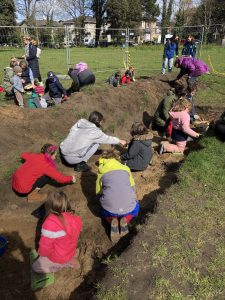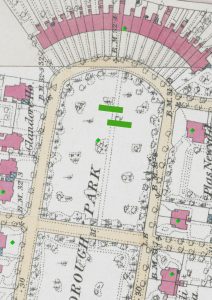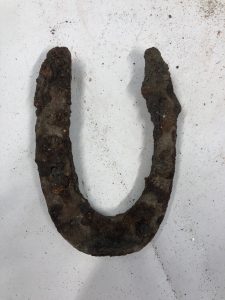 In the Spring, we went out to Ellenborough Park East (near the seafront) and held an archaeological excavation. We had a few different sessions with our home educators, our YAC Rusty Club and other families. Whilst the weather did delay us a couple of times, we pushed on and dug 2 trenches in the middle of the park in an area where there was previously a path running from each end of the park. We based our trench locations on historic maps using Know Your Place North Somerset.
In the Spring, we went out to Ellenborough Park East (near the seafront) and held an archaeological excavation. We had a few different sessions with our home educators, our YAC Rusty Club and other families. Whilst the weather did delay us a couple of times, we pushed on and dug 2 trenches in the middle of the park in an area where there was previously a path running from each end of the park. We based our trench locations on historic maps using Know Your Place North Somerset.
 Why Ellenborough Park East?
Why Ellenborough Park East?
We decided to dig in Ellenborough Park East because it is an open, safe and local space where we can practice the process of an archaeological excavation without disturbing too much wildlife or too many people. Ellenborough Park West is a Site of Special Scientific Interest, so we can’t dig there as it would disturb too much nature.
What were we hoping to find?
Ellenborough Park East dates back to the Victorian era (Ellenborough Crescent was built in 1855) and has been largely undisturbed since then, so we were hoping that there would be lots of Victorian finds to examine. We were definitely right about the number of finds! We found all sorts of bits and bobs from building material and brick to ceramics and glass. We gathered, cleaned and identified the finds back in the museum with our home educators and Rusty Club, before they were checked over and recorded by North Somerset Council’s Archaeologist, Cat Lodge and Grace, a work experience student from Kings of Wessex Academy in Cheddar.
 What can we tell from the finds?
What can we tell from the finds?
The vast majority of the finds were likely rubbish from building and domestic activities; they were scattered shards and chunks, rather than whole complete items. The land there was originally sand dunes and it’s likely that the park was initially levelled or has been smoothed over in places by using material from surrounding activities, basically rubbish. But rubbish from the past can tell us lots about what people were doing, what they were buying and eating, and how they were living.
The children and families all had a great time learning about what considerations go into an archaeological excavation and being able to have a go themselves.
 What was our star find?
What was our star find?
A group favourite was the donkey shoe! Donkey shoes are like horse shoes but slightly smaller and more oval in shape; this metal shoe was quite rusty but you can still very plainly make out the shape. You can even imagine how it might have got lost when it came loose from a donkey’s hoof as it walked back home through the park from a hard day’s work on the coast. Donkeys were used by the Victorians and even the preceding inhabitants, not only to give visitors a ride, but also to transport goods and luggage around the town – they were hard working animals.
What happens to the finds now?
Now that we’ve sorted, identified and counted the finds, the information will go into a report. This will add to our knowledge about the area and what happened in the past and will be added to the Historic Environment Record, which is publicly accessible. Some of the finds have been kept for use in learning activities and the rest will be responsibly disposed of.
If you’d like to know more about what learning and family activities we get up to at the museum, you can find out more on the Schools and Learning pages or the Whats On page of the Weston Museum website, or you can follow us on social media.
